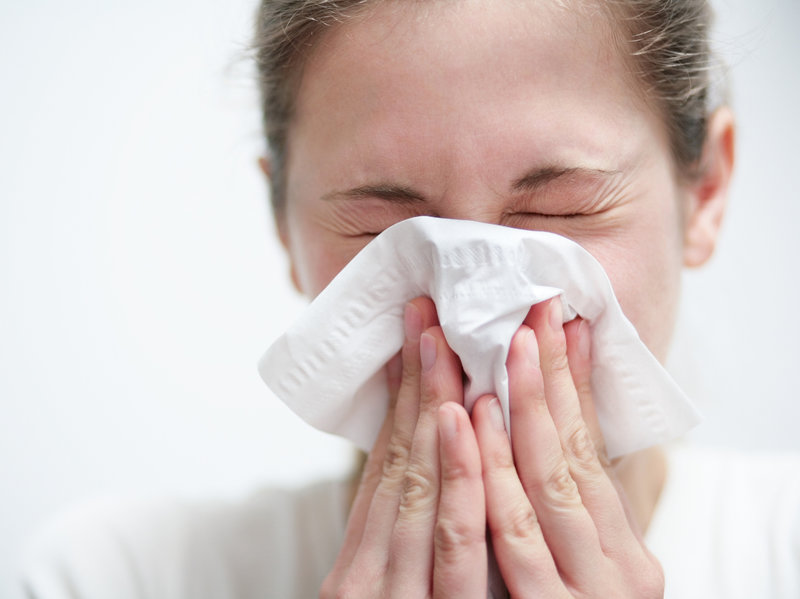What are skin allergies?
Allergies are your body’s reaction to a substance it views as a harmful “invader.” For example, coming into contact with what is normally a harmless substance, such as pollen, might cause the immune system (the body’s defense system) to react. Skin allergy is also known as urticaria or hives. Substances that cause these reactions are called allergens.
What is an allergic reaction?
An “allergic reaction” is the way the body responds to the allergen. A chain of events occur that result in an allergic reaction.
The first time an allergy-prone person is exposed to a specific allergen (such as pollen), the body responds by producing allergic (IgE) antibodies. The job of these antibodies is to find molecules of the offending substance in the bloodstream and tissues and to usher them to the body’s mast cells (a type of white blood cell) for destruction. As the mast cells destroy the allergens, a chemical called histamine is released into the bloodstream. A large amount of histamine swells body tissues, causes red, itchy, raised welts on the skin that appear in varying shapes and sizes; each one characteristically lasts no longer than 24 hours. Also increases secretions( watering from nose and eyes), and causes bronchospasm (tightening of muscles that surround the airways leading to difficulty in breathing).

What are the types of allergies and how are they treated?
People can be allergic to a wide variety of substances; the most common are pollen and dust mites. Other airborne allergens include molds and animal dander.
- Pollen:- Seasonal allergic rhinitis, or hay fever, is an allergic response to pollen. It causes inflammation and swelling of the lining of the nose and of the protective tissue of the eyes (conjunctiva). Symptoms include sneezing, congestion (feeling stuffy), and itchy, watery eyes.
- Dust mites:- Dust mites are tiny organisms that live in dust and in the fibers of household objects, such as pillows, mattresses, carpet, and upholstery. Dust mites especially love warm, humid areas. The symptoms of dust mite allergy are similar to those of pollen allergy.
- Molds:- Molds are parasitic, tiny fungi (like Penicillium) with spores that float in the air like pollen. Mold is a common trigger for allergies. Mold can be found indoors in damp areas, such as the basement or bathroom, as well as outdoors in grass, leaf piles, hay, mulch, or under mushrooms.
- Animal dander:- Allergic reactions can be caused by the proteins secreted by sweat glands in an animal’s skin, which are shed in dander, and (to a lesser extent) by the proteins in an animal’s saliva.
- Certain foods:- Food allergies develop when the body develops a specific antibody to a specific food. An allergic reaction occurs within minutes of eating the food, and symptoms can be severe. In adults, the most common food allergies are shellfish, peanuts, and tree nuts; in children, they include milk, egg, soy, wheat, shellfish, peanuts, and tree nuts.
Does everyone get allergies?
No. Most allergies are inherited, which means they are passed on to children by their parents. People inherit a tendency to be allergic, although not to any specific allergen. If a child develops an allergy, it is very likely that at least one of his or her parents has allergies.
What are the symptoms of allergies?
Allergy symptoms can be classified as mild, moderate, or severe:
- Mild reactions include local symptoms (affecting a specific area of the body) such as a rash or hives; itchiness, watery/red eyes, hay fever, and runny nose. Mild reactions do not spread to other parts of the body.
- Moderate reactions include symptoms that spread to other parts of the body. Symptoms may include itchiness, hives, and/or swelling, and trouble breathing.
- A severe allergic reaction, known as anaphylaxis, is a rare, life-threatening emergency in which the body’s response to the allergen is sudden and affects the whole body.
What medicines can I take for allergies?
Urticaria can occur at any age from childhood to the elderly. Urticaria in children need special attention as infection and food allergens are the important trigger.
Here we are sharing few important tips that you might find helpful if you are facing an urticaria problem
Do’s
- Understand and avoid trigger conditions suggested by a healthcare provider.
- Call a health care provider if you develop a swollen tongue, lips, or face.
- Try to modify your lifestyle.
- Try to relax and destress. (Yoga/ Meditation/ Music).
Don’ts
- Avoid eating histamine-rich foods (wine, beer, fermented food, dried fruits, citrus fruits).
- Avoid using harsh soaps or washing the skin too much.
- Avoid scratching your skin- itch triggers further itching.
- Avoid wearing woolen clothes.
- Avoid using any drugs without a dermatologist’s prescription.
- Urticaria treatments include identifying urticaria cause from history and lab tests and treatment with antihistaminics depending on the severity.
- Antihistamines block histamine, a trigger of allergic swelling. They can calm itching, runny nose, and hives.
- Mast cell stabilizers keep your body from releasing histamine. This can help with itchy, watery eyes or an itchy, runny nose.



